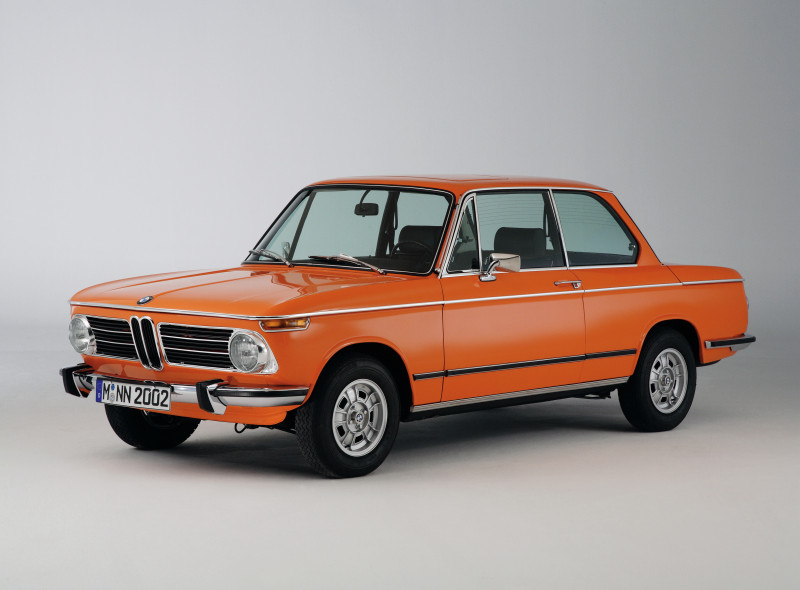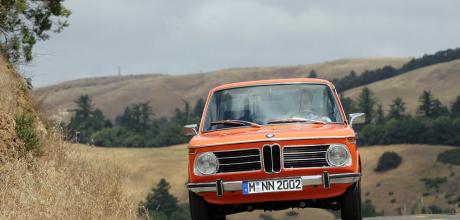Celebrating five decades of the 1971 BMW 2002tii E10
Launched in 1971, the 2002tii celebrates its 50th birthday this year, we take a look at it with the help of The 02 Register. Words: Simon Jackson, Richard Stern. Photography: BMW Classic, Richard Stern.
Tii 50 MEET THE FAMILY AT Celebrating five decades of the 1971 BMW 2002tii
Mention the ‘2002’ and – for many BMW enthusiasts – the word ‘Turbo’ springs instantly to mind. The larger than life 2002 with big wings and an even bigger power output is undoubtedly a standout icon in the model range, but, arguably, it is not the thinking man’s 2002. That accolade goes to a “lesser” model, an all-rounder with linear power delivery and a tight little chassis – a generally more usable version, and one that is far cheaper to buy and run to boot. That model is the 2002tii and this year it turns 50. The Turbo came late in the 2002 story, so too the tii which arrived in the UK in 1973.

It built on what the 1600ti brought to the table, not just with a second ‘i’ denoting its fuel injection system, but with a larger 1990cc version of the M10 engine too, in combination good for 130hp at 5800rpm with 130lb ft of torque at 4500rpm. This in a car that weighed only 1000kg. Richard Stern, Chairman 02 Register, ‘Friend of the Marque’ and Register Director BMW Car Club GB Ltd, takes over: “BMW certainly saved the best 2002 until last with the tii. When it first came out in the 1970s the tii was easier to live with than a Turbo, that is still true today. A good sorted tii take you across Europe with little drama,” Richard smiled. “Launched in 1971, the 2002tii used the same elegant bodyshell as its two-door relations. The differences to the regular 2002s were thicker rear trailing arms, bigger front brakes, different front suspension legs, bigger cylinder head exhaust valves and, obviously, the mechanical Kugelfischer fuel injection pump – the injectors were capable of delivering a healthy 130hp.“A larger twin air filter cylinder box was fitted, and an uprated alternator which was relocated lower on the engine – making it a pain to replace! The tii was available in both round rear light cluster and the later square lamp guise – including Lux trim models.”
“Sir Stirling Moss had the importer convert a standard Touring to tii specification”
BMW first attended to intentions to introduce the tii on US shores, though its hopes would be dashed thanks to strict US emissions controls, so it was 1973 before the UK market saw the car – just two years before the 2002 range was discontinued to make way for the arrival of the E21 3 Series. British journalists raved about the tii, which was good because it was far from cheap. At £2300 it was almost double the price of some competitors. Autocar reported: ‘The tii is a fast car by any standards; not so much in its maximum speed as in mid-range acceleration. It has few peers when it comes to hustling across country on mediocre roads; none at all, perhaps, if one considers the comfort and quietness that go with it.’ So, just what was so special about it? Well, that engine for one, as Richard continues: “Power came from the (aforementioned) two-litre four-cylinder engine, with a top speed of 118mph and 0-60mph time of just 8.3-seconds. Economy was good too, even on a long run a tii could see better miles per galllon than its 2002 or ti (twin carb LHD) relations. In fact, a tii could eat a first generation Golf GTI for lunch in both performance and top speed, what’s more the GTI came out in the late 1970s – long after the tii ceased production. You could argue that the Touring tii was really the first ‘hot hatch’, not the Mk1 VW Golf GTI.”
Where the 2002 Turbo left viewers in no doubt of its model type or inherent performance, the tii was subtle, very subtle with its latent talents almost concealed. “On the exterior the only way you know it’s a tii is when it passes you and you see the badge on the rear panel! Otherwise externally there are no visual clues that it is something special.” Richard said. “On the interior the only obviously difference from a standard 2002 was the rev counter to back-up the theory that this was a proper driver’s car, and the clock was moved to the centre of the dash in an additional pod.”
The engine was mated to a four-speed manual gearbox while a 25 percent limitedslip differential added to the recipe, the MacPherson struts up front and semi-trailing arms out back delivering a real driver’s car experience on the road.
When we last drove one we reported: ‘The tii is an absolute blast to drive. Much in the way that a modern icon like the 1 Series M Coupé demands that you get hold of it by the scruff of the neck, the ’02 begs to be given a thorough work out, seemingly coming alive the faster you go. As you’d expect grip isn’t up to modern levels but it still manages to cling on pretty tenaciously, but unlike in a modern machine, which will tend to grip and grip and then let go, the tii sends you plenty of warnings that it’s about to demand half an armful of opposite lock. There’s a nice degree of bodyroll and the steering gives plenty of feedback, as does the seat of your pants. It’s superbly adjustable and an absolute hoot to pedal along.
‘It might lack a little in the luxuries that we take for granted these days but the cabin is light and airy, there’s plenty of space for two in the back, three at a push, and the boot is decently sized, too. If you’re looking for a machine that’s not overly complicated, is fun to drive and shouldn’t break the bank then the ’02 really does take some beating.’
On driving pleasure, Richard seemingly agrees: “A good tii will still handle well even by today’s motoring standards, it’s still a quick, fun car,” he enthused. “A well set-up tii rarely goes wrong, it has a relay to inject extra petrol via a separate valve during cold starting. On the side of the pump is a warm-up unit and once again when set-up properly these cars are pocket rockets. Don’t be put off by the complexity of a tii, as there are people who can help and plenty of videos online to help.”
It’s all sounding great, but at 50-years of age, even the youngest of examples is far from a spring chicken.
“Finding a good, clean 2002 tii these days is near impossible. Like many cars of the era, the ones still left fall into two distinct categories; they’re either completely clappedout, rusted and full of dents, or they’re meticulously maintained, and, by now, properly reconditioned and driven regularly by people who care,” Richard said. If that hasn’t put you off then read on!
“The tii Tourings were only officially made in left hand drive, though Sir Stirling Moss had the importer convert a standard Touring to tii specification from new when they came out! “You’ll find restoration projects, or scruffy examples, can be had for around £10,000 or so, this is an awful lot of money to pay for a project that will cost you thousands more to fully restore. Better cars start at closer to £20,000, and £25,000 is not over the top for something that’s tidy and in reasonable mechanical shape, but check it out thoroughly as to ensure it’s not a shiny piece of rubbish that, in actual fact, needs that full restoration.” With the values of good quality classic BMWs going only one way, what might one expect to pay for the very best condition examples, we wonder?
“Minters with service history – and not a blemish to be seen – are closer to £40,000 upwards, and these tend to change hands within BMW clubs. Values in the US are very strong too, a mint tii may change hands for just under $100k – really! But then a good tii really is scarce these days, I have several people constantly looking to buy good cars and rarely do any come to market, so my advice is not to argue over £500 here or there or be too fussy over colour! It’s highly unlikely that you’ll find the exact car that you want, and it might take you years to find another one.” The best advice to anyone buying a classic car fits here – always buy the very best example you can afford – or in this case, find! Restoring a basket case is not for the for the faint of heart and is likely to prove a good way to burn through pots of cash. But if you can find a good car then you’re in for a real treat. This is one 50- year old that’s not in need of a facelift.
“The tii is in fact one of the very best classic BMWs,” Richard smiled. “So much so that, in 2006, BMW Mobile Tradition made a completely new tii from new parts in a glass-fronted workshop to celebrate the BMW marque, and to show that BMW in modern times is committed to helping keeping its history on the road, it was the tii that was chosen to represent that.”
THANKS Web: www.bmw2002.co.uk/the-02-register
Period adverts played on the model’s performance, and rightly so – this was a quick little BMW!
The tii in numbers:
LHD tii 27,572
USA tii 7,447
2000 tii Touring 5,058
RHD tii 3,678
2002 tii Touring 723
Total built 44,478
TECHNICAL DATA FILE
- ENGINE: In-line four-cylinder, eight-valve, single overhead camshaft, Kugelfischer injection
- CAPACITY: 1990cc
- COMPRESSION RATIO: 9.5:1
- MAX POWER: 130hp @ 5800rpm
- MAX TORQUE: 130lb ft @ 4500rpm
- TOP SPEED: 120mph
- 0-62MPH: 9.0-seconds
- ECONOMY: 25mpg
- WEIGHT: 1010kg
- TRANSMISSION: Four-speed manual, limited-slip differential
- SUSPENSION
- FRONT: MacPherson struts and anti-roll bar
- REAR: Trailing arms, coil springs and anti-roll bar
- STEERING: Worm and roller
- BRAKES: discs (front); drums (rear)
- WHEELS: 5x13-inch steel; 5.5x13-inch alloy option
- TYRES: 165/70 HR13
- PRICE: £2300(1973), £1000+(today)
- NUMBER MADE: 44,478



The 2002tii hits 50 this year, and it’s still looking fantastic, isn’t it?
nice pre 3-Series compact BMW sports sedan